
| The splendor falls on castle walls And snowy summits old in story; The long light shakes across the lakes, And the wild cataract leaps in glory. Blow, bugle, blow, set the wild echoes flying, Blow, bugle; answer, echoes, dying. dying, dying. O, hark, O, hear! how thin and clear, And thinner, clearer, farther going! O, sweet and far from cliff and scar The horns of Elfland faintly blowing! Blow, let us hear the purple glens replying, Blow, bugle; answer, echoes, dying, dying, dying. O love, they die in yon rich sky, They faint on hill or field or river; Our echoes roll from soul to soul, And grow for ever and for ever. Blow, bugle, blow, set the wild echoes flying, And answer, echoes, answer, dying, dying, dying. "The Splendor Falls On Castle Walls" (From "The Princess") Alfred Tennyson |
Even after having seen it twice and gestated it for a few days longer than a prompt review would have demanded, the latest installment of the Washington National Opera’s “American Ring” by Francesca Zambello has yet to sink in. Most of my attempts to describe it end in hesitation and ellipses of thought.
The easiest option might be to sidestep any kind of judgment and merely 'describe'. But then I just set out parameters against which to judge this attempt when I previewed this production in “Wagner’s Ring: Tension and Delight”.
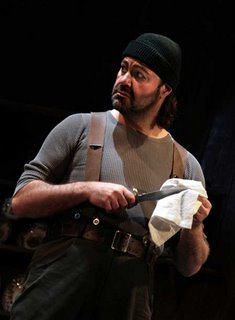 Perhaps judging Zambello’s Die Walküre is so difficult because I myself am so conflicted about it. It’s difficult to say straight out that it’s a failure, because it’s such a fine, ambitious, and potential-laden failure. It is part of a project I find exhilarating; it’s the absolute right thing to do for the Washington National Opera if it wants to raise its profile and offer challenging art and make a contribution to the art-form as such. The sense of excitement of attending an ‘event’ was palpable on opening night at the opera house. A rarity in Washington, that's much needed in order to make opera something other than an expensive high-society playground for blue-haired blue blood. By its daring and ambition alone, the American Ring (AR) will be bound to be among the proudest chapters of the WNO. That the individual instances of it, on their first time around, were fraught with problems will be forgotten soon enough.
Perhaps judging Zambello’s Die Walküre is so difficult because I myself am so conflicted about it. It’s difficult to say straight out that it’s a failure, because it’s such a fine, ambitious, and potential-laden failure. It is part of a project I find exhilarating; it’s the absolute right thing to do for the Washington National Opera if it wants to raise its profile and offer challenging art and make a contribution to the art-form as such. The sense of excitement of attending an ‘event’ was palpable on opening night at the opera house. A rarity in Washington, that's much needed in order to make opera something other than an expensive high-society playground for blue-haired blue blood. By its daring and ambition alone, the American Ring (AR) will be bound to be among the proudest chapters of the WNO. That the individual instances of it, on their first time around, were fraught with problems will be forgotten soon enough.
Criticism of Die Walküre and the AR from me feel like a patriot criticizing his beloved country’s policies, because he or she thinks that they don’t do the country’s greatness proud. Mme. Zambello should understand, because judging from her Ring interpretation and presentation, she must care for the USA very much indeed. After all, her criticism of the country and its history is broad and seething. And – it should be said – heavy handed.
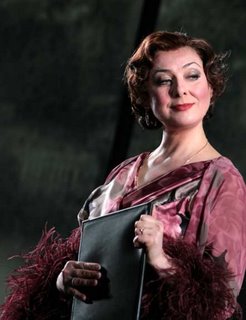 One of the problems of the AR is that it is weighed down by Mrs. Zambello’s peculiarly one-dimensional, trite political slogans. The perspective she offers in her direction of Die Walküre and the notes on the opera for the program are as subtle and nuanced as Charlton Heston’s view on gun control, although on the other side of the political spectrum.
One of the problems of the AR is that it is weighed down by Mrs. Zambello’s peculiarly one-dimensional, trite political slogans. The perspective she offers in her direction of Die Walküre and the notes on the opera for the program are as subtle and nuanced as Charlton Heston’s view on gun control, although on the other side of the political spectrum.
“Nature: The despoiling of nature through greed and ambition begins even before the stage action does […]. The destruction of our nation’s environment also began early in our history, with the violation of our rich natural resources and the pollution an disfigurement of our landscape, which will surely lead us to our demise if left unchecked.”
“Love: One need only read the newspapers (not to mention our history books) to see [the] theme [of the sacrifice of love and ethics on the altars of capitalism and temporal power] played out daily in America.”
“The deeper our team [- this is all written by Cori Ellison, dramaturg of the Ring cycle for the WNO] has delved into the Ring, the more we’ve found it a cautionary tale – and today, we ourselves seem to be living somewhere in Act II of Götterdämmerung. We very much hope that by touching our audiences “where they live,” we may help to halt, or at least slow down, our precipitous slide towards Act III.”
I don’t even know where to begin, this is so simplistic and wrongheaded. Perhaps the suggestion that the creative teams wants to contribute to being perpetually stuck in the second act of Die Götterdämmerung scares me the most. The work ends on a note of redemption, after all. Admittedly via a cleansing by fire and water – but then redemption always comes at the cost of death in Wagner and I reckon it’s symbolic, perhaps, not literal? At any rate, you can’t love Wagner enough to want to hang around Hagen & Co. ad infinitum. At the very idea of it, self-immolation becomes a very attractive alternative.
Ms. Zambello need not be able to show political or ideological refinement. Strong convictions generally come to an artist’s advantage, not detriment. But the quality of thought, if it has to be stamped all over a universal work like Wagner’s Ring, is important. Primitive slogans (that should offend even those who agree with the basic ‘message’) will unlikely yield inspired insights. “War bad – Nature good” and “Capitalism bad – Love good” are superficially sound principles (well, to sell capitalism as “bad” in this country might prove a tad difficult) but scarcely enough so as to present the Ring Cycle in an innovative light. It’s merely an infusion of a little politics, a little rant – and it gets old pretty quick. There are elements in this Ring, so far, that are a hodge-podge of George Bernard Shaw’s Ring analysis (“The Perfect Wagnerite”) meets Greenpeace meets Womyn Now! meets Cindy Sheehan. Noble goals for sure… but a mix that few would necessarily want to ingest with their Wagner.
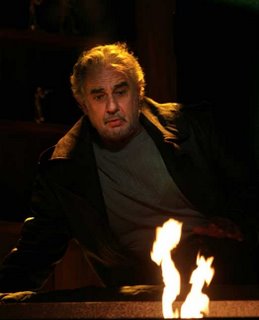 If these themes had been part of a coherent narrative, all might have been forgiven. (Much is forgiven, as it is…) One could disagree (which is an essential part of art, after all), but admire and marvel. There’s still admirable and marvelous stuff in this Ring. But cohesiveness and linearity are not among them. All that is good or bad or even just a matter of taste in this Ring comes as moments, instances, sections. Sets are mere props, rarely, if at all, are they integrated into a bigger narrative. A thousand ideas, ranging from inspired to insipid, jostle about in Die Walküre and offer enough for three Ring Cycles to be forged out of it… but none lead logically to another, no idea is necessitated by its preceding one. It feels like Ring-Cycle-by-Commission:
If these themes had been part of a coherent narrative, all might have been forgiven. (Much is forgiven, as it is…) One could disagree (which is an essential part of art, after all), but admire and marvel. There’s still admirable and marvelous stuff in this Ring. But cohesiveness and linearity are not among them. All that is good or bad or even just a matter of taste in this Ring comes as moments, instances, sections. Sets are mere props, rarely, if at all, are they integrated into a bigger narrative. A thousand ideas, ranging from inspired to insipid, jostle about in Die Walküre and offer enough for three Ring Cycles to be forged out of it… but none lead logically to another, no idea is necessitated by its preceding one. It feels like Ring-Cycle-by-Commission:“Hey – I’ve got a great Idea for the Valkyries: We’ll make them paratroopers! Modern fighers…” [In a sense, as paratroopers, they became 'Airmen-collectors' - I'm just glad they weren't Marines... !] – “Oh… and I have the perfect setting for them: We’ll set them on a Nazi bunker on Omaha Beach!” – “How about Wotan as this big early capitalist Robber Baron in New York with the setting of Walhalla as a leather and dark wood board room?!?” – “Brilliant!” “Could we make Fricka this coy, pre-feminist (yet svelte) 1930’s woman?” “Maybe Hunding as ‘rural Pennsylvania’ Deer Hunter type… with a healthy dose out-West pioneer spirit thrown in and his hut, at first, faintly reminiscent of Wood Grant’s American Gothic?”. “We’ll use it all.”
Mike Silverman, 'American Ring' Loses Citizenship Claim (Associated Press, March 25) Tim Page, WNO's 'Walkure' Takes Flight (Washington Post, March 26) T. L. Ponick, Singing 'Walkure's' praises (Washington Times, March 26) Charles T. Downey, American Ring Cycle Continues (DCist, March 26) Tim Smith, 'Walkure' with American twist simply soars in Washington (Baltimore Sun, March 31) |
That bombers and warplanes and even helicopters were projected on the scrims in the prelude to act III might lead one to deduct the subtle message that “war is bad!”. But it also confuses. Not only are we being jostled forward by several decades (now somewhere between 1945 and 1970), we clearly see the US Air Force in these bombers. And the parachuters are members of the 82nd Airborne, securing the beachheads in France during Operation Overlord. (A Vietnam-era helicopter further distracts a little, but let’s ignore that for a second.) Clearly those soldiers were – even to the most dedicated peacenik – the “good ones”; for once fighting an indisputably just war, no? Aside, it accompanies the Walküre-music, and those are the good gals, right? I was confused then, and still am. (Later I hear from the director herself that that was a “mixed metaphor” – which helps, in as far as it justifies my confusion; confusion being a principle characteristic of mixed metaphors.)
 It’s visually exciting, a coup d’théâtre, and perhaps most memorable (conductor Heinz Fricke, who first saw it during a final rehearsal, expressed to me the surprise this scene presented him with in a few, pricelessly matter-of-factly, words: “The curtain opens – suddenly I’m looking at parachutes dangling on stage…”), but if you start thinking about it, you will look for the connection to the other scenes and be puzzled: The “out-West” first act, the act two / scene one boardroom (if Wotan had had a board, he would not have been in all that trouble in the first place – it must be a CEO’s office with an oversized table and too many chairs), or the ‘urban decay’ goes ‘Lost Highway’ atmosphere of act two / scene two – set under a dilapidated highway overpass amid rabble and garbage where Sieglinde nearly gets raped by Hunding’s gunwielding henchmen. (The German Shepherds from Zambello’s Fidelio make a cameo.) The only connection that is easily perceived is that to an abstract sense of America(na) in each case, but little else. Enough to impress in the theater but too little to allow for meaningful intellectual digestion and gestation once one leaves the opera house.
It’s visually exciting, a coup d’théâtre, and perhaps most memorable (conductor Heinz Fricke, who first saw it during a final rehearsal, expressed to me the surprise this scene presented him with in a few, pricelessly matter-of-factly, words: “The curtain opens – suddenly I’m looking at parachutes dangling on stage…”), but if you start thinking about it, you will look for the connection to the other scenes and be puzzled: The “out-West” first act, the act two / scene one boardroom (if Wotan had had a board, he would not have been in all that trouble in the first place – it must be a CEO’s office with an oversized table and too many chairs), or the ‘urban decay’ goes ‘Lost Highway’ atmosphere of act two / scene two – set under a dilapidated highway overpass amid rabble and garbage where Sieglinde nearly gets raped by Hunding’s gunwielding henchmen. (The German Shepherds from Zambello’s Fidelio make a cameo.) The only connection that is easily perceived is that to an abstract sense of America(na) in each case, but little else. Enough to impress in the theater but too little to allow for meaningful intellectual digestion and gestation once one leaves the opera house.Completely maddening are the projections that are shown during the orchestral preludes. Although once again filled with decent ideas, the the slightly digitized and distorted footage, too abstract and then too literal at the same time, is of unfortunate low quality. Running through the forest – in the style of the first person camera perspective popularized by the Blair Witch Project – is feigned, although the camera moves actually slowly and is just shaking uncontrollably. Up the river through the mountains through some very literal clouds we suddenly look up a modern short skyscraper. I get it: Wotan the God cum Business man in his Capitalist Walhalla… but it all looks like a cheap, student-made Windows screensaver. (Why is the skyscraper on the projection a modern one but his boardroom set around the 30’s?) In final scene, Brünnhilde’s rock is surrounded by fire. The fire is real – gas lights up the area behind and to the sides of Wotan’s favorite girl’s resting place. It is impressive and would be more impressive, still, if it continued in front of her, also. (It might be too close to the curtain for that.) But the emitting smoke, with the potential to turn even modest flames and additional red light into a stunning effect, turned out to be a pitiful plume blown into the air, but never settling, much less billowing. Smoke from dry ice has little staying power and unions probably won’t allow for anything else… but it was an opportunity to visually knock the last scene out of the park, sadly not capitalized on.
Wonderful little touches (Wotan throwing himself at Brünnhilde’s feet in pained agony perfectly captured their relation and particular situation) could be found next to senseless ones (Why was Brünnhilde picking up the phone in the boardroom while talking to her father? Whom could she possibly have wanted to call at that point? Why did the Valkyries install the black and white hero-pictures on the Valkyrie-rock when they are merely meeting there to install them later, in Walhalla?)
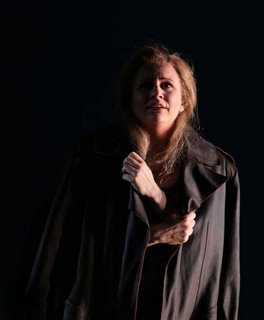 If only some of its ideas were tied into a more cohesive whole, the “American Ring” would be a glorious success, I am sure. But until then it will be an interesting but episodic staging of Wagner’s operas; dependent for its success on the singing more so than ideally necessary. Washington’s cast fortunately fits that bill: Alan Held as Wotan and Anja Kampe are magnificent and quickly ensure that the confusion caused by the set is absorbed by the singing. Ten minutes into every set, their seemingly arbitrary nature ceases to matter on account of their work. Ms. Kampe’s diction which I lamented in 2003 was better and her voice richer and more elegant, still. Held was regal and felt, accurate as ever, and should be one of the most demanded Wotans of our time, if he isn’t already. Elena Zaremba, so magnificent as Frica in 2003 at DAR Constitution Hall, no longer has the same voice. Something happened, and it wasn’t good to her instrument. It now comes with a dark hue, worn-out vibrato, and overly dramatized pushing of the voice. But Mme. Zaremba makes up in sublime acting what she may no longer be able to do with her voice. On a recording that may not console, but in the theater it makes (almost) all the difference.
If only some of its ideas were tied into a more cohesive whole, the “American Ring” would be a glorious success, I am sure. But until then it will be an interesting but episodic staging of Wagner’s operas; dependent for its success on the singing more so than ideally necessary. Washington’s cast fortunately fits that bill: Alan Held as Wotan and Anja Kampe are magnificent and quickly ensure that the confusion caused by the set is absorbed by the singing. Ten minutes into every set, their seemingly arbitrary nature ceases to matter on account of their work. Ms. Kampe’s diction which I lamented in 2003 was better and her voice richer and more elegant, still. Held was regal and felt, accurate as ever, and should be one of the most demanded Wotans of our time, if he isn’t already. Elena Zaremba, so magnificent as Frica in 2003 at DAR Constitution Hall, no longer has the same voice. Something happened, and it wasn’t good to her instrument. It now comes with a dark hue, worn-out vibrato, and overly dramatized pushing of the voice. But Mme. Zaremba makes up in sublime acting what she may no longer be able to do with her voice. On a recording that may not console, but in the theater it makes (almost) all the difference.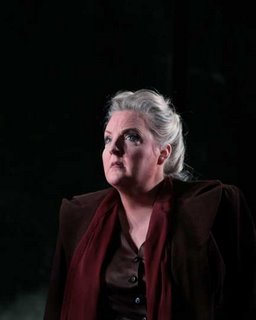 Linda Watson is a little too close to the stereotype of Brünnhilde than I am comfortable with: a stern, unforgiving, strong, blond lady with (imaginary) horns. Her singing can’t be faulted, even if it mostly leaves me cold. Her acting is good, although it never touches me. The pronunciation is good enough for Bayreuth, where she sang Brünnhilde in this year’s Ring, but it still offered a few smirk-inducing moments. Gidon Saks proved a stentorian Hunding, rough, raw, unpleasant (as a character, not as a singer, where he was excellent), fearsome, menacing. Plácido Domingo, loving and admiring him as we do, does not get younger, and a Siegfried that is older than Hunding and Wotan combined necessitates a good amount of suspension of disbelief. I know that he still works on his pronunciation and diction in German (when many singers of lesser stature would have long stopped to bother) but it’s all still rather awkward. At times it was completely impossible to gather what he was singing or whether he was starting to forget his lines or not. And yet every minute of what he produces is well worth hearing. At the premiere there were eight Valkyries in addition to Brünnhilde, which is the recommended number. (Jane Ohmes – Gerhilde, Caroline Thomas – Helmwige, Stacey Rishoi – Waltraute, Heidi Vanderford – Schwertleite, Beverly O’Regan Thiele – Ortlinde, Claudia Huckle – Siegrune, Rebecca Ringle – Rossweisse.) In subsequent performances, I am told, illness has reduced that number to six, with the dutiful sisters taking over the vocal parts of their indisposed siblings.
Linda Watson is a little too close to the stereotype of Brünnhilde than I am comfortable with: a stern, unforgiving, strong, blond lady with (imaginary) horns. Her singing can’t be faulted, even if it mostly leaves me cold. Her acting is good, although it never touches me. The pronunciation is good enough for Bayreuth, where she sang Brünnhilde in this year’s Ring, but it still offered a few smirk-inducing moments. Gidon Saks proved a stentorian Hunding, rough, raw, unpleasant (as a character, not as a singer, where he was excellent), fearsome, menacing. Plácido Domingo, loving and admiring him as we do, does not get younger, and a Siegfried that is older than Hunding and Wotan combined necessitates a good amount of suspension of disbelief. I know that he still works on his pronunciation and diction in German (when many singers of lesser stature would have long stopped to bother) but it’s all still rather awkward. At times it was completely impossible to gather what he was singing or whether he was starting to forget his lines or not. And yet every minute of what he produces is well worth hearing. At the premiere there were eight Valkyries in addition to Brünnhilde, which is the recommended number. (Jane Ohmes – Gerhilde, Caroline Thomas – Helmwige, Stacey Rishoi – Waltraute, Heidi Vanderford – Schwertleite, Beverly O’Regan Thiele – Ortlinde, Claudia Huckle – Siegrune, Rebecca Ringle – Rossweisse.) In subsequent performances, I am told, illness has reduced that number to six, with the dutiful sisters taking over the vocal parts of their indisposed siblings.Heinz Fricke undoubtedly tried his best with the Washington National Opera orchestra, and he has come a long way. But opening night was still ‘rough goings’. An overtaxed battery of brass consistently denied premium service to the music; especially in the first act. Insecurity and stiffness in most sections lent little credence to Fricke’s assertion that the WNO orchestra is one of the absolute top orchestras – even if he then modified that by adding “opera-orchestras” and “in the United States”.
All performances are sold out, which is wonderful. Because this review fails to capture the excitement present at the performances. It likely fails to convey how enjoyable the direction (and of course the music) still is... sometimes almost despite itself. And how important this approach to opera is for anyone who wants to keep opera a living and hopefully controversial art-form. Fraught with problems? From my point of view, Yes. But doing just the right thing, all the same. A production that is – finally – worth debating and arguing about. That’s more than can be said about most American productions these days.
All Photos by Karin Cooper, Washington National Opera
No comments:
Post a Comment